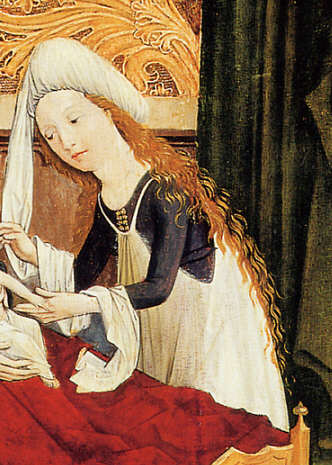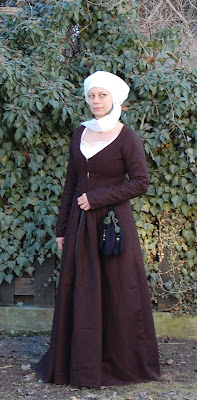This weekend we held the annual Lucia-feast (in Sweden we celebrate the sicilian saint of S:a Lucia the 13th of December), the Barony of Styringheim baronial investiture. One of our eager new members (not yet a year in the Society) wanted to autocrat, but asked for someone more experienced to help out. I thought that it had been a good while since I did something and that it might be payback-time, for I do love going to events. And soon we were three autocrats, Fenja, me and Mark. As the plans formed we realised that we couldn´t get hold of anyone to do the feast, so I said that I could do that, disregarding the fact that I have never made a feast this big, with help from others that volunteered to make one dish each.
I asked around for tips, went through recipes and food blogs and formed a meny that was varied, with mostly quite simple but tasty dishes since I thought that after a long day in cold weather, people would not be appreciative of a complicated meny with strange dishes.
And in order to hopefully get some out-of-the kitchen time during the Saturday I started on Friday the 13th with the preparations and made most of the dishes in the Student Union kitchen that we got to borrow for the day. Then we stuffed everything into the fridge in the actual event kitchen at Kapitelhusgården (the Chapter House in Visby,
http://kapitelhusgarden.se/). When we arrived the next morning to start cooking lunch and the rest of the feast, we were met by a rather foul smell when entering the kitchen building. I thought it smelled of gas and every surface was covered in soot. We soon discovered that the fridge we had put all the food in the night before had burned during the night, some kind of electrical malfunction, but apart from the soot nothing was damaged. Of course we had to call the fire brigade, that came really fast, since a fire in the old medieval town core is frightful should it spread between the tight fitted and old buildings. They checked everything with their heat-camera and could, thankfully, soon tell us and the managers that no fire had spread inside the building. The manager that left last the night before had closed the door to the kitchen area and thus the fire was probably drained of oxygen and died. (here is a report in the local paper about the fire with a picture of the burned fridge:
http://www.helagotland.se/nyheter/artikel.aspx?articleid=9196671)
Well, we could for sure not use this kitchen and people were coming into the yard, ready for the first court of the day. We opened the fridge to see if anything of the food could be salvaged and, to our surprise, it was all intact and still cold. Safely capsuled in it had survived and could still be served. We loaded everything into a car, stayed for the court and then rushed down back to the Student Union kitchen, were they had not yet cleaned up after their bar emptying the night before. So we started with clearing the kitchen before we could get cracking with the lunch.
We did manage to do the entire feast in time, borrowing all kitchen utensils, cantines, serving spoons and all and drove back to the site in time to put up the feast before the evening court ended. We even got the feast hall lit up with candles before the guests arrived. Not the prettiest serving and not one I would be proud of under different circumstances, with recycled plastic cantines with butter and sauces, aluminum foil wrapped around the pots and pans and not enough serving spoons. Right about then I thought I for sure deserved a beer and to sit down for a while. But we made it! I´m so proud of everyone that helped out and made it possible.
And the feast was great, with our own Lucia-tradition of strange men in even stranger outfits singing the classical advent songs to the audience´s awe and applause. And one of the firefighters might be recruited as member, he left with a leaflet.
 |
| View of the Chapter house when the feast had started |
This is what we served:
Ham
Lumbard Mustard
Oven-baked salmon
A green herbal sauce with vinegar and breadcrumbs
Fricadelli in almond-sauce
Cheese-lasagna
Llentilles
Onion and mushroom-pie
Bread with rosewater
Knäckebrod
Honey butter
Cinnamon butter
And no less then three desserts plus cookies!
Doucettes with saffron cream filling
A 14th C cake with dried fruit and nuts
A rather improvised Sambocade with saffron instead of rose water and elder flowers
And for those asking for recipes, here´s some links:
http://lethemboyle.com/15th-century/sauce-verte/
I used parsley, basil, sage, some freshly ground black pepper, breadcrumbs (that you can buy gluten-free!) and white wine vinegar, lots of it.
http://lethemboyle.com/15th-century/doucetes/
I made one lactose free pie, and five ordinary ones.
http://lethemboyle.com/14th-century-2/lumbard-mustard/
For the sambocade, I used all the leftover eggwhites since most f the dishes called for eggyolks, some quark a little sugar and lots and lots of saffron. Blended well and baked in the oven for about 20 minutes. A great dessert and entirely gluten free.
































































